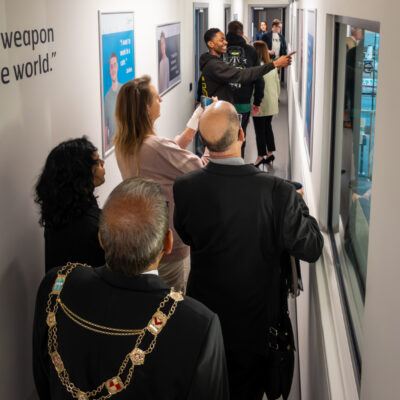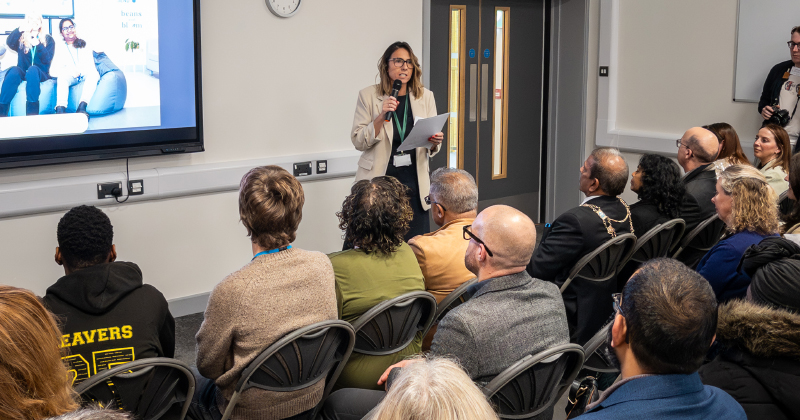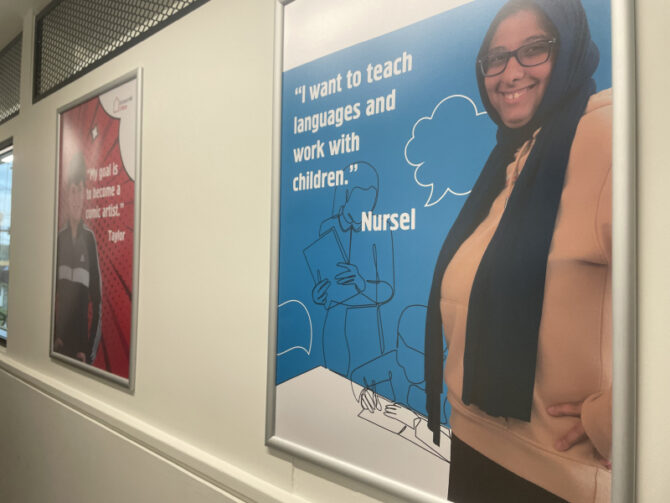“You don’t need planning permission to build castles in the sky,” proclaims a Banksy quote painted across the crisp white walls as you enter the newly refurbished Sutton Life Centre.
It’s an apt welcome to a building that is the embodiment of a partnership between a local authority and a specialist FE college that, on paper, might sound fanciful given today’s fractious SEND-funding landscape.
The centre, which houses Orchard Hill College learners and Sutton Council’s preparation-for-adulthood hub, offers something rare: a space where education, support services and community life overlap, aiming not just to teach young people with SEND but to alleviate the “cliff-edge” they face when support services stop once they turn 18, highlighted in a review by Ofsted and the Care Quality Commission.
It is one of several collaborations between FE community partners across the country aimed at tackling the SEND crisis.
Today, local dignitaries are treated to iced cupcakes after a whistlestop tour of the centre’s climbing wall, sports pitch, sensory garden, PS5 gaming zone, radio studio (where Lib-Dem leader Ed Davey has already been grilled on a student-run podcast), a public library and a café providing real work experience.
By day, the space hosts students on vocational pathways and provides a hub for teacher training. When college hours end, the lights will stay on for sports sessions, advice for young people and families, and perhaps even a nightclub.
“It’s a place for young people to feel seen, supported and part of a community,” says college executive principal Kelly Phillips.
The facility looks expensive, with the cost split between the college and the council. But Kieran Holliday, director of education, integrated support and safer communities at the London Borough of Sutton, says the investment should save the council money. Sutton is forecasting a £23.2 million DSG (direct schools grant) deficit – a debt echoed across many councils.

A SEND system in deep crisis
Demand for education, health and care plans (EHCPs) continues to surge. There were 638,700 plans nationally as of January, with some areas reporting 25-45 per cent annual spikes.
While demand accelerates, the quality of SEND commissioning continues to deteriorate.
Out of 29 area SEND inspections by Ofsted last year, only four were judged positive. More than half were deemed “inconsistent,” and nine cited “systemic failings”. Families increasingly feel they must fight to secure suitable provision. SEND tribunal appeals rose by 55 per cent in a single year to 2023-24.
Meanwhile, pressure on councils is reaching unsustainable levels. Post-16 transport costs have doubled in real terms over eight years. Councils have no duty to provide transport for students aged 19-25 with EHCPs, or any post-16 learners, and many are shifting costs onto families. Sheffield proposes increasing parental contributions from £540 to £1,000. Sutton is forecasting a £1.55 million saving after introducing charges.
The Sutton Life Centre, originally opened in 2010 as a youth hub to make young people more ‘street smart’, fell out of regular usage after Covid.
It is one of 10 sites that Orchard Hill now operates across London as part of its “vision” to “set up in local areas where there’s demand, so people don’t have to travel an hour and a half on a bus to get there”, says Phillips.
Sutton’s high-needs debt means it would have been invited to join the government’s safety valve programme, which has negotiated 38 deficit-reduction deals with local authorities. But a year ago the government froze entry to new councils, leaving Sutton facing £1 million a year in lost interest income or additional borrowing costs on those debts.
Last week’s government budget revealed that from 2028, SEND cost pressures will instead sit on central government’s books, potentially creating a £20 billion time bomb if councils’ existing SEND deficits are accounted for.

FE needs different solutions
Clare Howard, CEO of Natspec, the national body for specialist FE colleges, is concerned that the issues the government is focused on solving through its delayed schools’ white paper and SEND reforms (now expected in January) – addressing spiralling costs and early identification of need – “do not affect FE”.
Specialist colleges educate only 3 per cent of all FE students with SEND; 90 per cent of FE learners with EHCPs are already in general FE colleges. Howard rejects the idea that post-16 SEND costs are driving national financial instability.
Young people aged 16-25 account for 26 per cent of EHCPs but receive less than 10 per cent of high-needs funding. “FE requires different solutions to different problems,” she says. “FE providers and young people aged 16 to 25 must not be grouped under reforms designed for schools and children.”
As Orchard Hill College is a sponsor of an academy trust of 14 special schools, Phillips gets insight into both school and college specialist sectors.
She highlights how specialist colleges do not get access to government capital building grants provided to FE colleges and special schools.

Demand rising faster than provision
Nationally, demand for specialist provision continues to outstrip supply. The number of placements in independent and non-maintained special schools has jumped 14 per cent in a year. One tenth of children and young people with EHCPs are now out of school, home-educated, NEET or waiting for a placement.
Orchard Hill College, rated outstanding, receives “100 times more” placement requests than it has capacity for, says Phillips.
But local authority cost-saving measures mean that placement requests are often turned down by councils; the Association of Colleges reports that more than two-thirds of colleges have had admissions decisions overruled by local authorities.
Natspec describes some local authorities as being “reluctant” to place some young people at 19 in specialist FE if they are unlikely to enter employment in the future, “steering them towards adult social care instead”.
“This indicates a lack of understanding of specialist FE and one of its core purposes: building independence, skills, and meaningful learning outcomes,” it said.
Furthermore, when young people with complex needs are given unsuitable placements in general FE colleges, without adequate preparation or staffing, those learners experience a renewed “cliff-edge” when those placements break down, says Phillips.

Nicola Hawkins, the head of college at Ambitious College, run by the charity Ambitious about Autism, says local authority cost-saving schemes like the safety valve agreement have “often” made it “more challenging to have places funded” at the college. Another representative of post-16 specialist provision said their local authority was “not able to increase our places in FE because their funding is being spent in the pre-16 arena”.
Furthermore, local authority delays in commissioning specialist FE places, often due to funding disputes and tribunal cases, are leaving young people out of education for many months before they can access a specialist FE placement.
Hawkins describes funding decisions being made as late as September for placements offered in February. “This impacts autistic young people massively on transition and outcomes of next destination,” she adds.
A recent AoC report highlights the importance of strategic planning for placements; “some needs could be met if provision was planned ahead,” it said.

Rebuilding a broken system
In Sheffield, which is now projecting a DSG deficit of up to £60 million unless spending is dramatically reduced, a devastating SEND area inspection earlier this year identified “systemic failings”.
For Maria Swift, Sheffield’s post-16 SEND lead, the inspection was a turning point. “We had to repair our very broken system,” she says. A major gap was identified in post-16 capacity for young people with complex needs, with families often fighting for limited placements in special schools.
“We didn’t have enough confidence in our system for young people to move on at the right time, through nobody’s fault – decisions about young people’s futures were often coloured by lack of aspiration,” Swift adds.
The council convened a roundtable with The Sheffield College and local special schools to review long-standing issues with data and planning. Outdated EHCPs, featuring “primary need” categories that no longer reflected students’ realities, were skewing data and masking emerging needs.
The local authority took their findings “on the chin”, says Sarah Le-Good, assistant principal at The Sheffield College. But she had to navigate cultural differences between the sectors to come up with solutions: “I talk apples, but my special schools talk bananas”.
A deep data trawl produced a five-year map of need in the city and revealed a striking number of EHCPs requiring “secure” provision, preventing young people from leaving sites independently.

Swift found this “very worrying”. “Are we locking up these young people for life?” she says.
The college identified an unused corner-plot campus and developed plans for an additional 100 high-needs places. Demand quickly surpassed expectations: This year’s numbers are “significantly higher” than the 565 initially planned for, with 700 places requested for next year.
Le-Good sees it as a “real privilege” to be a general FE college (she’s “never used the word mainstream, because nothing is mainstream”) with specialist provision nestled within their site.
But it is a “really hard message” for parents to be told their young person will have to leave their special school. So the college is engaging families earlier on, offering “soft” careers guidance to students with more complex needs before they reach year 11.
The college’s new guide for young people with SEND to plan their post-16 journey “enables different conversations” for neurodiverse young people who are “possibly in a trauma state in a meeting about their future”.

“It’s a physical document that gives them a sense of confidence… it tells them they do have a future.”
Sheffield’s SEND review uncovered deep gaps in provision of level 2 and below, which was not aligned to local labour-market needs.
In response, The Sheffield College created Bloom, a curriculum co-produced with schools, health professionals and parents which focuses on “core competencies” where qualifications aren’t always appropriate and prioritises practical, hands-on learning.
“It’s not about replicating other specialist provision,” Le-Good says. “It’s about pushing learners to achieve what they’re capable of.”
Swift says the council’s parent carer forum, which can be “feisty”, has cautiously embraced the approach. “They’ve challenged us and corrected us – it’s been a two-way process.”

The employment puzzle
Photographs of learners sharing their hopes for life after college adorn Sutton Life Centre’s corridor walls; Mason tells of wanting to become a beautician, Nursel of wanting to teach languages and Joshua of wanting to work in a café.
For Phillips, “these aren’t just decorative pieces; they are reminders of the possibility and ambition of our young people”.
The college has had real success helping its learners find work; nationally only 5 per cent of adults with a learning disability are in paid employment, which Phillips describes as “shocking”, but for her former students, it is 79 per cent.
Phillips believes that her young people “have a lot to offer” the economy; she recounts stories of how when other employees are off during adverse weather conditions, her young people will “walk four miles in the snow to get there, because that job matters” to them.
Learners working at entry level and level 1 are often missing from local skills improvement plans (LSIPs) and national disability employment initiatives, which Howard says “overlooks the key reality that many young people with complex needs want to work”.
David Holloway, the Association of Colleges senior policy manager on SEND, believes that tackling the disability employment gap requires employers to become “more confident to employ young people with SEND”. The movement of responsibility for post-18 skills to the Department for Work and Pensions could therefore be “very positive and lead to a stronger focus on skills for work”.
Orchard Hill checks in on its past learners every six months to ensure they have continued support, but it is a service they are not funded for. What makes Sutton Life Centre unique is that if that young person’s access to work breaks down, the college can refer them to social workers on site who can “pick that person back up”, says Phillips.
“It gives young people a place where support continues, where they can return and get guidance, take part in activities and remain part of a community that understands and champions them.”

College-college collaborations
Natspec says the “binary” nature of place planning systems in general FE and specialist colleges, and subcontracting rules, make partnerships between them “very difficult”.
But there are notable successes where specialist organisations have partnered with general FE colleges to provide on-campus provision. The autism charity Ambitious about Autism operates co-located campuses at West Thames College in Isleworth and Capital City College in Tottenham, as well as three supported internship programmes.
Hawkins sees the collaboration the charity has with West Thames College as a “true partnership” rather than a “tenancy agreement”, as is often the case with similar arrangements elsewhere.
Co-location means her autistic learners are not “separated away”. It enables the charity to support a “broad breadth of learners”, from those “on the sensory level that need quite intensive support through to learners that are nearly work ready, and every learner in-between”.
It is particularly helpful for those learners with “the capability of accessing a level 1 to 3 course within the mainstream college, but who need specialist support around their autism”.

Meanwhile, a lack of suitable local specialist provision for young adults with complex needs prompted Heart of Worcestershire College (HOW) to subcontract National Star, a specialist college based in Gloucestershire, to deliver learning, therapy and care at their campus.
Learners are registered on HOW’s individualised learner record, making HOW accountable for their outcomes and welfare. But the team delivering programmes are employed by National Star, who assess and manage learners’ programmes.
“What you don’t see in a business plan and costings is the value of trust and the importance of shared ethos and culture,” says National Star’s CEO Lynette Barrett. “You can’t calculate that in a tender bid, yet it is critical for this type of partnership to work.”
Back at the Sutton Life Centre, Phillips reflects that something rarer than planning permission was required to realise its ‘castle in the sky’: a belief that SEND provision can be transformed when partners choose not to work in silos.
“Partnership solutions to SEND challenges are the thing I believe in most in my career,” she says. “It’s not about us, or about education or health alone. It’s about all the partners working together to meet young people’s needs.”
